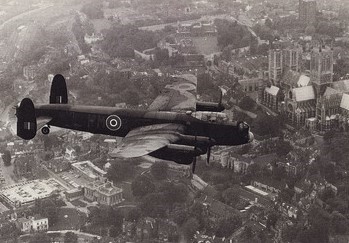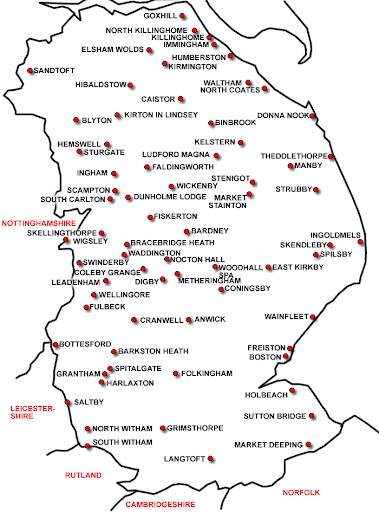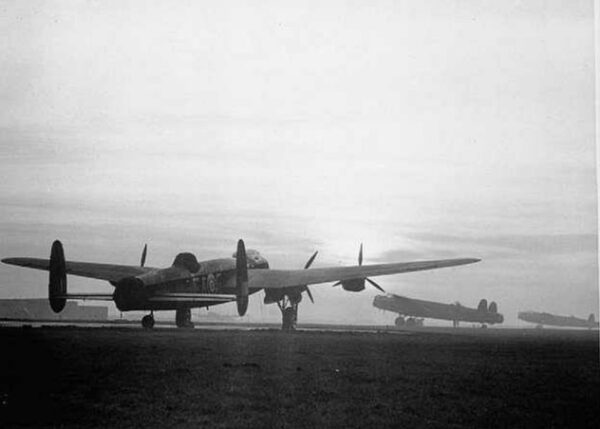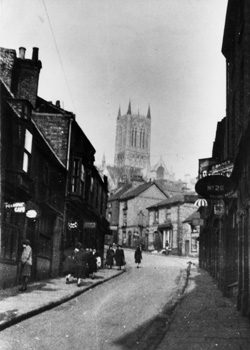Research
Research
Research
Lincolnshire – Bomber County
During the Second World War, Lincolnshire became a vital centre for Britain’s air war—earning its enduring title: Bomber County. With more RAF airfields than any other county, and Lincoln Cathedral standing watch over returning crews, this corner of England was the heart of RAF Bomber Command’s operations over Europe.

Lancaster over Lincoln, 103 Sq.
(Credit: IBCC Digital Archive).
Why Lincolnshire?
Lincolnshire’s flat, open terrain made it ideal for building long runways needed for heavy bombers like the Lancaster. Its position on the east coast provided direct access to targets in occupied Europe, while the relative remoteness of its farmland allowed new airfields to be built quickly and discreetly. By the war’s peak, over 50 operational airfields dotted the county.

Map of Lincoln’s Bomber Command Bases
The Airfields and Squadrons
Some of the most famous squadrons in RAF history flew from Lincolnshire bases:
- RAF Scampton – Home to the legendary 617 Squadron, the “Dambusters,” who launched the daring Ruhr dams raid (Operation Chastise) in May 1943.
- RAF Waddington – Base of No. 44 Squadron (Rhodesia) and No. 463 Squadron (RAAF), pioneers in the use of the Lancaster.
- RAF Coningsby – Hosted No. 61 Squadron and later 617 Squadron, as now the home to the Battle of Britain Memorial Flight.
- RAF East Kirkby – Home to No. 57 and 630 Squadrons, now preserved as the Lincolnshire Aviation Heritage Centre.
- RAF Skellingthorpe – Just west of Lincoln, this important base housed No. 50 and 61 Squadrons, flying Hampdens, Manchesters, and ultimately Lancasters. Today, Birchwood housing estate occupies the site, but memorials and street names commemorate its past.

Avro Lancasters at dispersals at sunset, before taking off from Scampton, Lincolnshire on a bombing raid.
The nearest aircraft is a Mark I, R5751 ‘EA-E’, of No. 49 Squadron RAF, normally based at Fiskerton, also in Lincolnshire.
(Credit:IWM)
Flying Through the Weather
Crews at these stations faced more than just enemy fire—Lincolnshire’s unpredictable weather often proved just as deadly. Fog, heavy rain, and snow caused frequent cancellations and complicated night-time landings. Many aircraft were lost on return due to poor visibility, just miles from home.
Lincoln: A City of Comfort and Resolve
Lincoln itself provided both a spiritual and social anchor for the aircrew. The Cathedral, visible for miles, was often the first sign of home for bombers returning in the early morning. In town, pubs, dance halls, and cinemas gave airmen a precious sense of normality between missions.
Local people welcomed aircrew from across the Commonwealth—New Zealand, Australia, Canada, Poland and more—into their homes and lives. Many friendships and romances began in Lincolnshire village halls, even as the spectre of loss was ever-present.

Lincoln wartime 1943.
(Credit:BBC)
Legacy and Remembrance
Today, the sacrifice and service of Bomber Command is honoured at the International Bomber Command Centre (IBCC) on Canwick Hill, overlooking Lincoln. Featuring:
- The 102-foot Memorial Spire (the height of a Lancaster wingspan)
- The Walls of Names, engraved with over 55,000 Bomber Command dead
- Extensive digital archives and exhibitions
the IBCC ensures the legacy of Lincolnshire’s air war is preserved for generations.
We Remember
Lincolnshire was not just a backdrop to history—it was where history took flight. From the determination of aircrew to the quiet resilience of rural communities, Bomber County remains a symbol of courage, sacrifice, and unity.
For more on local airfields, or to explore the maps of Lincolnshire’s wartime stations:
📍 Interactive Map of Lincolnshire’s WWII Airfields (Bomber County Aviation Resource)
📍 IBCC Relief Map of Bomber Command Airfields
July 13, 2025